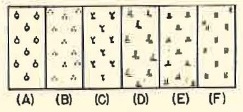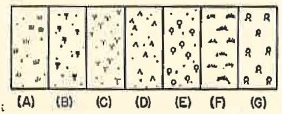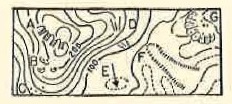CHAPTER 12 - GEOGRAPHIC AND MILITARY SIGNS

Section I. INTRODUCTION
1. SOURCES.
a. The geographis sigrns included under paragraph 1 of the next section are selected from those appearing on maps of the Japanese Empire prepared by the Imperial Land Survey Department. Variant or supplmnentary signs used by the Japanese Hydrographic Office are listed in paragraph 2.
b. The military signs and abbreviations included under sections III and IV have been selected from Supplement No. l of Japanese Field Service Regulations (Military signs), August l940 (Sakusen Yomurei Furoku Sono Ichi, Guntai fugo), and are supplemented by information from other sources. The grouping of the Army signs follows that adopted by the Japanese; the Navy and Special naval Landing Force signs are arranged arbitrarily. The abbreviations are arranged alphabetically.
2. GENERAL PRINCIPLES.
a. Military signs.
(1) General.
A study of Lhe list o{ Japanese military signs will reveal certain basic signs and principles, a knowledge oi which will aid in the interpretation of the signs. It is emphasized, however, that the Japanese do not exhibit a great degree of consistency in the fomation of their signs. Furthermore certain signs considered obsolete may recur, and individual initiative in the drawing of extemporary signs, with explanatory notes if considered necessary, is condoned by the Japanese.
(2) Basic sign.
Examples of basic signs follow:
 , field artillery;
, field artillery;  , cavalry;
, cavalry;  , engineers;
, engineers;
 , air (army);
, air (army);  , air (navy);
, air (navy);  or
or
 , tank;
, tank;  , shipping;
, shipping;  , signal;
, signal;  ,
radio;
,
radio;
(3) Headquarters.
Headquarters, down to the battalion level inclusive, usually are distinguished by flags and/or circles. Brigade or group heaquarters, however, are indicated by six-pointed stars
 . The appropriate basic sign may be
added to indicate the arm. For example:
. The appropriate basic sign may be
added to indicate the arm. For example:  area army headquarters;
area army headquarters;  ,
division headquaters;
,
division headquaters;  , cavalry brigade headquarters
, cavalry brigade headquarters  , infantry
battalion headquarters;
, infantry
battalion headquarters;  , field artillery regimental headquarters.
, field artillery regimental headquarters.
(4) Units.
The normal method of designating units is by adding a rectangle below the sign (in full or abbreviated) of the particular arm or weapon.
For example;
 , medium mortar,
, medium mortar,  , medium mortar unit;
, medium mortar unit;
 , engineer (basic sign),
, engineer (basic sign),  , engineer unit (an exception to this principle
should be noted:
, engineer unit (an exception to this principle
should be noted:  , field artillery,
, field artillery,  , field artillery ammunition train).
, field artillery ammunition train).
(5) Motorization.
In order to show that a unit is motorized, two rings (representing wheels) are added either below or at the side of the particular sign. For example:
 , field artillery ammunition train,
, field artillery ammunition train,  , field artillery
ammunitino train, motorized.
, field artillery
ammunitino train, motorized.
(6) Compound signs.
Basic signs such as those described above may be combined into compound signs. For example
 antiaircraft artillery regimental headquarters.
antiaircraft artillery regimental headquarters.
(7) Classification.
An appropriate symbol, number, or abbreviation (either English letters, "Kana", or characters) may be added to a sign when it is necessary further to classify the unit or equipment indicated by the sign. For example:
 , mobile ground radio station,
, mobile ground radio station,  , No 3 type mobile ground radio
station;
, No 3 type mobile ground radio
station;  , ship (general).
, ship (general).
 water supply ship (the character included means "water"),
water supply ship (the character included means "water"),  ,
armed ship;
,
armed ship;  motor truck,
motor truck,  , repair truck,
, repair truck,
 , truck loaded with machine guns;
, truck loaded with machine guns;  , tank
, tank  light tank.
The most common of such examples are noted on the list of signs.
light tank.
The most common of such examples are noted on the list of signs.
(8) Boundaries, directions.
Boundaries of districts or limits of fortified areas are shown by lines; directions of shooting, points of attack, and changes of direction of troops are shown by arrows.
b. Military abbreviations.
(1) English letters, both capital and small, normally used in military abbreviations.
(2) The basic army abbreviations appear in most cases to be derived from German words and, in the case of most recent additions, romanized forms of Japanese words. For example:
BA (Bergartillerie), mountain artillery;
ScE (Sempaku eiseitai hombu), shipping medical unit headquarters.
(3) Naval abbreviations are derived largely from English words and less frequently from romanized forms of Japanese words. For example:
BC, battle cruiser;
edg, comnined destroyer group;
AtB (Attached "butai"), attached force.
c. Numbers.
The numbers of units and weapons are shown by placing the appropriate figure, either Arabic or Japanese, with necessary additions, in parentheses after the particular sign or abbreviation. For example:
 (2), two airplanes; A
(2), two airplanes; A  three battalions of field artillery (two characters in
parentheses are, respectively, "three" and the first character of the Japanese word for "Battalion").
three battalions of field artillery (two characters in
parentheses are, respectively, "three" and the first character of the Japanese word for "Battalion").
d. Identification
(1) When it is necessary to distinguish between enemy and friendly forces, the Japanese show signs for the former in red, for the latter in blue.
(2) In indicating the organizational numbers of units, Arabic numerals usually are used for all units except battalions, for which Roman numerals are used. The number of the lower unit precedes that of the higher organizations of which it is a part, the two being separated by a slanting line. For example:
18 P, the 18th Engineers;
III/2i, 3d Battalion of the 2d Infantry Regiment.
II St/1A,
2d Battalion Ammunition Train of the 1st Field Artillery Regiment.
(3) Platoons and sections usually are shown as fractions of a company. For example:
1/4 2/1P. 1 platoon of th e2d Company of the 1st Engineer Regiment;
1/16 2/5i, 1 section of the 2d Company of the 5th Infantry Regiment.
(4) Missing units of an organization are indicated by numerals preceded by a minus sign, in parentheses. Units attached to an organization are shown similarly with a plus instead of a minus sign. For example:
2i (-7.8), 2d Infantry Regiment less the 7th and 8th Companies;
1 (+iP)/2i, 1st Company, plus a labor unit of the 2d Infantry Regiment.
SECTION II. WWII JAPANESE GEOGRAPHIC MAP SIGNS
1. IMPERIAL LAND SURVEY DEPARTMENT SIGNS.
| Num | Symbol | Description | Num | Symbol | Description | |
| 1 |  |
Navy lookout tower | 51 |  |
Battalion headquarters and garrison | |
| 2 |  |
Factory | 52 |  |
Regimental headquarters | |
| 3 |  |
Bank | 53 |  |
Naval station | |
| 4 |  |
Powder magazine | 54 |  |
Secondary naval station | |
| 5 |  |
Water wheel or mill | 55 |  |
Naval camp | |
| 6 |  |
Generating plant | 56 |  |
Army camp | |
| 7 |  |
Masonry wall | 57 |  |
Shipyard | |
| 8 |  |
Fences | 58 |  |
Prefectural seat | |
| 9 |  |
bamboo fences | 59 |  |
Sub-prefectural island office or gun seat | |
| 10 |  |
Stone wall | 60 |  |
City office | |
| 11 |  |
Stumps | 61 |  |
Town, village or ward office | |
| 12 |  |
Isolated trees | 62 |  |
School | |
| 13 |  |
Chimney | 63 |  |
Hospital | |
| 14 |  |
Triangulation point - above wsea level | 64 |  |
Isolation hospital | |
| 15 |  |
Secondary control point - Above sea level | 65 |  |
Gendarmeria post | |
| 16 |  |
Bench mark - Above sea level | 66 |  |
Police station | |
| 17 |  |
Spot elevation - Above sea level | 67 |  |
Court of appeals | |
| 18 |  |
Old battlefield | 68 |  |
Prison | |
| 19 |  |
Spring | 69 |  |
Customs house | |
| 20 |  |
Tomb | 70 |  |
Tax office | |
| 21 |  |
Castle site | 71 |  |
Forestry office | |
| 22 |  |
Volcano | 72 |  |
Mining office | |
| 23 |  |
Earthen wall | 73 |  |
Government monopoly bureau office or factory | |
| 24 |  |
Hedge | 74 |  |
Office of maritime affairs | |
| 25 |  |
Cemetery | 75 |  |
Meteorological station | |
| 26 |  |
Ditches | 76 |  |
Post office (with telegraph and telephone service) | |
| 27 |  |
Ditches | 77 |  |
Post office | |
| 28 |  |
Shrine gate | 78 |  |
Telegraph office | |
| 29 |  |
Stone lantern | 79 |  |
Telephone office | |
| 30 |  |
Monument | 80 |  |
Province (obsolete) | |
| 31 |  |
Statue | 81 |  |
Gun, shi or sub-prefectural | |
| 32 |  |
Signpost | 82 |  |
Ward, Machi or Mura (A)Fixed (B)Approximate | |
| 33 |  |
Stone steps | 83 |  |
Government lands | |
| 34 |  |
Crane | 84 |  |
Property lines (A)Fixed (B)Approximate | |
| 35 |  |
Oil well | 85 |  |
(A) Iron bridge (B) Wooden bridge (C) Foot bridge (D) Foot ford (E) Vehicular ford (F) Passenger ferry (single boat) (G) Passenger and horse ferry (two boats) (H) Steam ferry |
|
| 36 |  |
Mineral spring | 86 |  |
Height of bank | |
| 37 |  |
Material dump | 87 |  |
Depth of water | |
| 38 |  |
Mine | 88 |  |
Lighthouse | |
| 39 |  |
Boundary marker | 89 |  |
Radio mast | |
| 40 |  |
Shrine | 90 |  |
Warning signal | |
| 41 |  |
Temple | 91 |  |
(A) Flower garden (B) Grove (C) Truck garden |
|
| 42 |  |
Grave | 92 |  |
(A) Orchard (B) Tea (C) Mulberry (D) Cultivated marsh (E) Irrigated rice field (F) Dry rice field |
|
| 43 |  |
Pagoda | 93 |  |
(A) Wild land (B) Palm (C) Bamboo (D) Conifers (E) Broad leaf trees (F) Grass land (G) Jungle |
|
| 44 |  |
Church | 94 |  |
Boat anchorage | |
| 45 |  |
Japanese government building | 95 |  |
Ship anchorage | |
| 46 |  |
Foreign government building | 96 |  |
Anchorage | |
| 47 |  |
Military reservation | 97 |  |
Commercial port | |
| 48 |  |
Division headquarters | 98 |  |
Fixed beacon | |
| 49 |  |
Brigade headquarters | 99 |  |
Fixed beacon (lightless) | |
| 50 |  |
Fortress and defense headquarters | 100 |  |
Buoy (lightless) |
Table 2 - continued
| Num | Symbol | Description | Num | Symbol | Description | |
| 101 |  |
National highway | 108 |  |
Three uned roads: (A)Narrow (B)Wide | |
| 102 |  |
Main prefectural roads | 109 |  |
Power lines along road: (A)Ordinary (B)High tension | |
| 103 |  |
More than 3 meters wide | 110 |  |
Government railway: (A)Two tracks (B)Single track (C)Station | |
| 104 |  |
More than 2 meters wide | 111 |  |
Feeder railways: (D)Double (E)Single | |
| 105 |  |
More than 1 meter wide | 112 |  |
Boundaries: International | |
| 106 |  |
Less than 1 meter wide | 113 |  |
Prefectural (A)Fixed (B)Approximate | |
| 107 |  |
Impassable for carts | 114 |  |
(A) Cart (B) Rock outcropping (C) Scattered rock (D) Talus slope (E) Depression (F) Ravine, gully (G) Crumbling bank |
2. JAPANESE HYDROGRAPHIC OFFICE SIGNS
Signs listed are variant or supplementary to those in Paragraph 1 of this section; Japanese army shipping signs are listed in Paragraph 1, Section III of this chapter. Navy conventional signs in paragraph 2 of the same section.
| Num | Symbol | Description | Num | Symbol | Description | |
| 1 |  |
Large harbor or anchorage | 31 |  |
Drying coast line | |
| 2 |  |
Small harbor or anchorage | 32 |  |
Sand beach | |
| 3 |  |
Anchorage for junks | 33 |  |
Steep coast line | |
| 4 |  |
Ship entrance | 34 |  |
Reef | |
| 5 |  |
Ship anchorage with facilities | 35 |  |
10 fathom line (1 dot) | |
| 6 |  |
Ship anchorage | 36 |  |
20 fathom line (2 dots) | |
| 7 |  |
Possible anchorage | 37 |  |
50 fathom line (5 dots) | |
| 8 |  |
Emergency anchorage | 38 |  |
Government landing field | |
| 9 |  |
Possible emergency anchorage | 39 |  |
Commercial lanidng field | |
| 10 |  |
Lighthouse | 40 |  |
Emergency landing field | |
| 11 |  |
Lightship | 41 |  |
Seaplane anchorage with facilities | |
| 12 |  |
Lightbuoy | 42 |  |
Seaplane anchorage | |
| 13 |  |
Mooring buoy | 43 |  |
Possible seaplane anchorage | |
| 14 |  |
Buoys (in general drawn to represent the actual shape of the buoy) | 44 |  |
Emergency seaplane anchorage | |
| 15 |  |
Light beacon, fixed. | 45 |  |
Marine bureau | |
| 16 |  |
Flashing beacon: White | 46 |  |
Coast guard station | |
| 17 |  |
Flashing beacon: Red | 47 |  |
Lifeboat station | |
| 18 |  |
Flashing beacon: Green | 48 |  |
Observation point | |
| 19 |  |
Flashing beacon: Amber | 49 |  |
100 fathom line (10 dots) | |
| 20 |  |
Lighting facilities | 50 |  |
Flood tide | |
| 21 |  |
Submarine cable | 51 |  |
Ebb tie | |
| 22 |  |
Radio station | 52 |  |
Ocean current (directional and speed) | |
| 23 |  |
Radio broadcasting station | 53 |  |
River and stream Bridge Ferry |
|
| 24 |  |
Obstruction | 54 |  |
Waterfall | |
| 25 |  |
Tank (oil, gas or water) | 55 |  |
Lake | |
| 26 |  |
Race track | 56 |  |
Swamp and marsh | |
| 27 |  |
Golf links | 57 |  |
Fortified and aviation prohibited zone | |
| 28 |  |
Temple, shrine | 58 |  |
Civil air line | |
| 29 |  |
Imperial palace, garden, shrine, or mausoleum | 59 |  |
High voltage transmission line | |
| 30 |  |
Coast line |
SECTION III. MILITARY SIGNS
NOTE: The arrangement of the army signs follows that adopted by the Japanese, and is outlined below. The arrangement of the Navy and Special Naval Landing Force signs is arbitrary.
| Army Signs | Paragraph I | |
| Common to all arms: | ||
| Infantry, | ||
| Cavalry, | ||
| Artillery, | ||
| Engineers, | ||
| Air, Antiaircraft, and metereological, | ||
| Armored forces, | ||
| Field works, | ||
| Railway, | ||
| Shipping, | ||
| Signal, | ||
| Transport, supply, and medical services, | ||
| Line of communications, | ||
| Siege and fortress defense, | ||
| Navy Signs | Paragraph 2 | |
| Special Naval Landing Force Signs | Paragraph 3 |